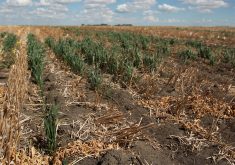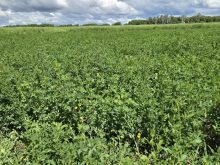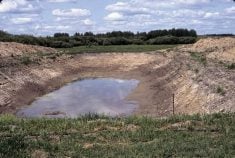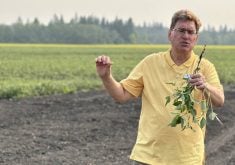Research team is working on breeding crops with better drought tolerance and reduced need for fertilizer
As climate change drills down on the growth and yield of corn crops, their roots’ abilities to access water and nutrients in hard, dry soils is becoming more challenging.
However, after more than a decade of research, scientists at Penn State University have made a discovery that could lead to a new variety of corn able to withstand drought and low-nitrogen soil conditions, potentially easing future global food insecurity.
The research team identified a gene encoding a protein that triggers a genetic sequence responsible for the development of a trait that enables corn roots to acquire more water and nutrients. The trait is called root cortical aerenchyma (RCA) and it allows air passages to form in the roots, making them metabolically cheaper (or more organically effective) and able to explore the soil more efficiently.
Read Also

Anti-separatist movement targets rural Alberta
Former deputy premier Thomas Lukaszuk’s anti-separatism Alberta Forever Canada petition campaign expects to run full steam ahead into the province’s farming regions
“Our team is focused on understanding root traits that can be used to breed crops with better drought tolerance and reduced reliance on fertilizer,” said Jonathan Lynch, professor at the department of plant science. “For some years we have been researching RCA and its role in reducing the metabolic costs of soil exploration, which we have shown to be associated with better growth and yield of corn under drought stress and in soils with low nitrogen or phosphorus availability.
Because of these benefits, we consider RCA to be a useful target in crop breeding. We undertook genetic analysis of RCA in corn germplasm, which eventually led to the discovery of this gene controlling RCA formation.”
Beginning in 2010, more than 500 lines of corn were established at sites in Pennsylvania, Arizona, Wisconsin, and South Africa.
“It was difficult,” said Lynch. “The most challenging part was measuring RCA in maize roots from many plants grown in the field over several years. We developed a platform called anatomics, which involves excavating maize root crowns in the field, cutting off a piece of root from a standard location in the crown, preserving that segment in alcohol, and then later imaging the anatomy of that segment using a method called laser ablation tomography, which we also developed.”
Hannah Schneider, formerly a doctoral student and then postdoctoral scholar in the lab headed by Lynch, led the research.
“Understanding the genetic control of RCA formation took the group over 10 years,” said Schneider. “It involved growing tens of thousands of plants. We wanted to confirm that this gene really controlled RCA formation, so we put the plants through rigorous testing in many locations under a number of different stresses, including low nitrogen and drought.”
Schneider found the gene — the bHLH121 transcription factor — that causes corn to make RCA. But finding it and validating the genetic underpinnings of the root trait demanded prolonged effort.
Part of that testing included creating multiple mutant corn lines using genetic manipulation methods through the CRISPR/Cas9 system as well as gene knockouts.
The purpose was to show the association between the newly discovered gene and the formation of root cortical aerenchyma. Studies on the mutant corn line with both the newly discovered gene knocked out and a CRISPR/Cas9 mutant line gene edited to suppress its function both showed reduced RCA formation.
However, a corn line that was overexpressed showed significantly greater RCA formation. The tests underscored the importance of the gene for RCA formation in stressed soil environments, markers that can direct breeders to select specific varieties with improved soil exploration capabilities.
Lynch said that they evaluated the effect of RCA on corn growth and yield under several drought conditions.
“For drought studies, we tried to obtain between a one-third and two-thirds growth reduction caused by water deficit,” he said. “The soils and the rainfall in each of the locations are distinct, which gives us confidence that RCA is useful in many different environments.”
He wrote in the report that understanding the genetic architecture of root traits, or phenotypes, is essential when focusing on trait-based crop improvement. These traits come into play in the capture of soil resources, since roots are distributed both in space and time to forage different soil domains and successfully capture water and nutrients, thus delivering major improvements in crop production and yield.
While some corn lines make a lot of RCA, others make less and awareness of this knowledge will be helpful to breeders. For instance, Lynch said that breeders will be able to select lines that are expressing the gene at an optimum-specific level.
“With more research, we can discover which forms of this gene may be most useful,” he said. “Genetic markers such as this gene are especially useful when the trait itself (in this case RCA) is challenging to measure directly.”
He added that, since the gene already exists in corn, and already varies among corn lines, traditional hybridization from a breeding perspective should work well.
The research team is continuing to discover new root traits associated with better tolerance of dry, infertile soil. Schneider, now assistant professor of crop physiology at Wageningen University and Research in the Netherlands, reported her discovery of another corn trait, multiseriate cortical sclerenchyma. MCS, while present in some cultivars, was absent in others, including teosinte and landrace/wild races of grains.
“I think what is interesting is that landraces/wild crop ancestors/teosinte do not have MCS, yet modern cultivars do. It demonstrates that growth environments and cultivation systems have dramatically changed, and the plants may need to develop different traits to help cope and adapt to these different environments. For example, modern agroecosystems may have much harder soils compared to natural environments,” Schneider said.
The value of MCS in corn crops is that this greater efficiency to access water and nutrients may be able to compensate for less irrigation and fertilizer.
“More follow-up work on the trait may be needed to identify its benefits and trade-offs in different environments,” she said. “We know it is an important trait for compaction stress tolerance. In compacted soils, roots with MCS will be able to penetrate into deeper soils, accessing more nutrients and water. Potentially, this could enable growers to apply less irrigation and fertilizer.”
Lynch said that the results of the long study are significant because finding a gene behind an important trait that is going to help plants have better drought tolerance and better nitrogen and phosphorus capture is huge in the face of climate change.
The research was published in the Proceedings of the National Academy of Sciences.















